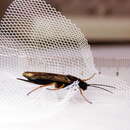en
names in breadcrumbs


Sirex is a genus of stingless wood-eating (xylophagous) wasps in the woodwasp family Siricidae, also known as horntails.The genus is native to the northern hemisphere.The 16 Sirex species known in the new world and Europe are fairly well-documented, but the Asian diversity of this genus is not well known (Schiff et al. 2012; Goulet 2012).Sirex larvae are wood-borers, and adult females have ovipositors modified for depositing eggs into the wood of host conifer trees.During oviposition, a female Sirex inoculates the tree with spores of wood-decay fungi (one of three Amylosterium species, phylum Basidiomycota. Like Sirex, Amylosterium is also native to the Northern hemisphere) that produces enzymes to break down cellulose.Larvae hatch and eat the fungus as well as the rotting wood for 1-3 years until they eclose as adults.The Sirex-Amylosterium relationship is obligate and symbiotic, the fungus benefits from a greatly increased dispersal to new hosts (Keeler 2009; Hajek et al 2013; Schiff et al. 2006, 2012).
In their native habitats, Sirex wasps attack only dead or diseased trees, so are not considered a pest species.However, the European/Asian/North African native S. noctilio has caused enormous damage to North American pine forests in Australia, South America and South Africa since being introduced to these countries, as this Sirex species attacks non-native hosts while still healthy, and furthermore secretes a toxic mucus which increases the speed that the tree succumbs to the wood rot (Schiff 2012).Because the larvae delve deep into the core wood, they are very hard to eradicate.Australia and New Zealand developed a bio-control program to control this pest, considered one of the most damaging pine forest invaders ever, using the introduction of nematode parasites Deladenus siricidicola. This has proven remarkably successful in the southern hemisphere, where no other Serix species exist.Recent introduction of S. noctilio into North America presents a significant threat to Canadian and American pine forests but the control landscape is considerably more complicated since there are 29 native species of Siricinae which would be affected by introducing parasitic nematodes; control measures may allow only containment of S. noctilio rather than full eradication (Evans-Goldner 1988; Williams et al. 2012).It is recognized that a better understanding of the relationship between Serix wasps and their fungal specie(s) is important in containing conifer forest damage (Hajek et al. 2013).
A biomimicry research group at Imperial College, London, has turned to the ovipositor of S. noctilio as inspiration for design of a long, flexible probe to access tumors in deep internal brain areas, potentially in order to perform multiple medical treatments such asbiopsies, placing electrodes or other instruments, delivering drugs or carrying out microsurgeries.The wasp ovipositor has a unique solution for penetrating materials without rotation, using a zipper-like mechanism where the two parallel halves create tension against each other to pull each other through the substrate; the stability of this system allows the apparatus to be virtually unlimited in length.You can read more about this project at: http://www3.imperial.ac.uk/mechatronicsinmedicine/research/biomimeticflexibleandsteerableprobeforneurosurgery and in the reference cited there.
Taking a cue from these wasps, whose flexible ovipositors drill through wood, researchers are testing needles with interlocking valves that can go long distances and be directed to tumors and around obstacles.